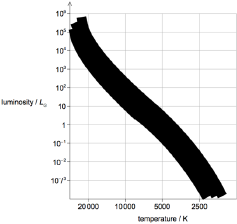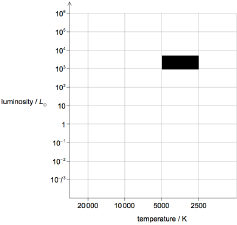| Date | May 2018 | Marks available | 1 | Reference code | 18M.3.SL.TZ2.11 |
| Level | Standard level | Paper | Paper 3 | Time zone | Time zone 2 |
| Command term | Outline | Question number | 11 | Adapted from | N/A |
Question
The following data apply to the star Gacrux.
\[\begin{array}{*{20}{l}}
{{\text{Radius}}}&{ = 58.5 \times {{10}^9}{\text{ m}}} \\
{{\text{Temperature}}}&{ = 3600{\text{ K}}} \\
{{\text{Distance}}}&{ = 88{\text{ ly}}}
\end{array}\]
A Hertzsprung–Russell (HR) diagram is shown.
On the HR diagram,
Main sequence stars are in equilibrium under the action of forces. Outline how this equilibrium is achieved.
A main sequence star P, is 1.3 times the mass of the Sun. Calculate the luminosity of P relative to the Sun.
The luminosity of the Sun L\(_ \odot \) is 3.85 × 1026 W. Determine the luminosity of Gacrux relative to the Sun.
The distance to Gacrux can be determined using stellar parallax. Outline why this method is not suitable for all stars.
draw the main sequence.
plot the position, using the letter P, of the main sequence star P you calculated in (b).
plot the position, using the letter G, of Gacrux.
Discuss, with reference to its change in mass, the evolution of star P from the main sequence until its final stable phase.
Markscheme
photon/fusion/radiation force/pressure balances gravitational force/pressure
gives both directions correctly (outwards radiation, inwards gravity)
OWTTE
[2 marks]
«L \( \propto \) M35 for main sequence»
luminosity of P = 2.5 «luminosity of the Sun»
[1 mark]
LGacrux = 5.67 × 10–8 × 4π × (58.5 × 109)2 × 36004
LGacrux = 4.1 × 10–29 «W»
\(\frac{{{L_{Gacrux}}}}{{{L_ \odot }}}\) «= \(\frac{{4.1 \times {{10}^{29}}}}{{3.85 \times {{10}^{26}}}}\)» = 1.1 × 103
[3 marks]
if the star is too far then the parallax angle is too small to be measured
OR
stellar parallax is limited to closer stars
OWTTE
[1 mark]
line or area roughly inside shape shown – judge by eye
Accept straight line or straight area at roughly 45°

[1 mark]
P between \(1{L_ \odot }\) and \({10^1}{L_ \odot }\) on main sequence drawn
[1 mark]
at \({10^3}{L_ \odot }\), further to right than 5000 K and to the left of 2500 K (see shaded region)

[1 mark]
ALTERNATIVE 1
Main sequence to red giant
planetary nebula with mass reduction/loss
OR
planetary nebula with mention of remnant mass
white dwarf
ALTERNATIVE 2
Main sequence to red supergiant region
Supernova with mass reduction/loss
OR
Supernova with mention of remnant mass
neutron star
OR
Black hole
OWTTE for both alternatives
[3 marks]

